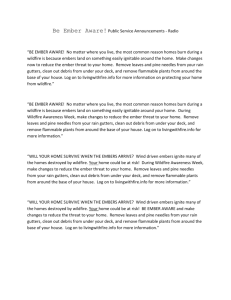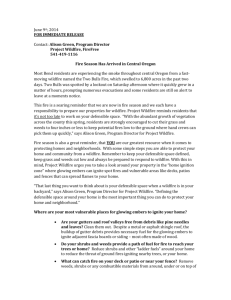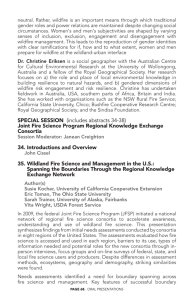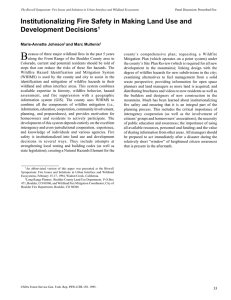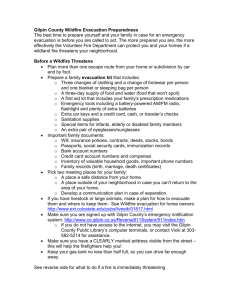Tips To Improve Family and Property Survival During A Wildfire
advertisement
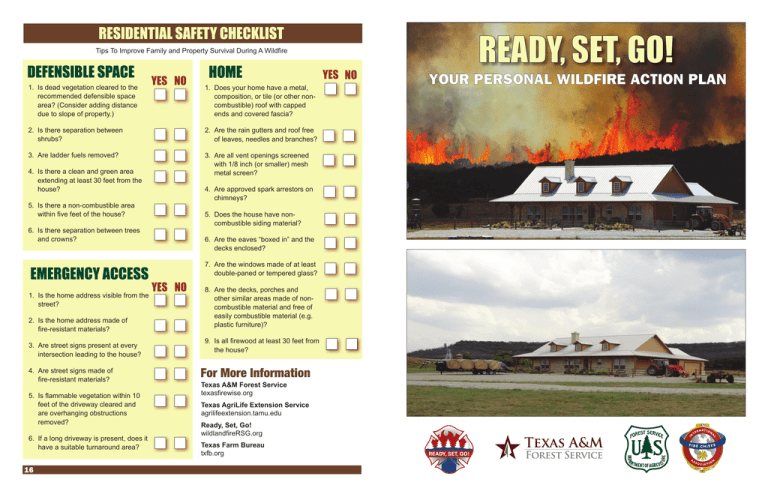
Tips To Improve Family and Property Survival During A Wildfire 1. Is dead vegetation cleared to the recommended defensible space area? (Consider adding distance due to slope of property.) 1. Does your home have a metal, composition, or tile (or other noncombustible) roof with capped ends and covered fascia? 2. Is there separation between shrubs? 2. Are the rain gutters and roof free of leaves, needles and branches? 3. Are ladder fuels removed? 3. Are all vent openings screened with 1/8 inch (or smaller) mesh metal screen? 4. Is there a clean and green area extending at least 30 feet from the house? 5. Is there a non-combustible area within five feet of the house? 6. Is there separation between trees and crowns? 4. Are approved spark arrestors on chimneys? 5. Does the house have noncombustible siding material? 6. Are the eaves “boxed in” and the decks enclosed? 7. Are the windows made of at least double-paned or tempered glass? 1. Is the home address visible from the street? 2. Is the home address made of fire-resistant materials? 3. Are street signs present at every intersection leading to the house? 4. Are street signs made of fire-resistant materials? 5. Is flammable vegetation within 10 feet of the driveway cleared and are overhanging obstructions removed? 6. If a long driveway is present, does it have a suitable turnaround area? 8. Are the decks, porches and other similar areas made of noncombustible material and free of easily combustible material (e.g. plastic furniture)? 9. Is all firewood at least 30 feet from the house? Texas A&M Forest Service texasfirewise.org Texas AgriLife Extension Service agrilifeextension.tamu.edu Ready, Set, Go! wildlandfireRSG.org Texas Farm Bureau txfb.org Preparing for the devastation of wildfire on your ranch can protect your family, property and livelihood. If the time comes for you to leave your headquarters or homestead behind, you will want to know that you have done everything possible ahead of time to prevent costly losses. Saving Lives and Property through Advance Planning he fire season is now a year-round reality in many areas, requiring firefighters and residents to be on heightened alert for the threat of wildfire throughout the year. Each year, wildfires consume hundreds of homes in the Wildland Urban Interface (WUI). Studies show that as many as 80 percent of the homes lost to wildfires could have been saved if their owners had only followed a few simple fire-safe practices. In addition, wildfire-related deaths occur because people wait too late to leave their home. Your fire department takes every precaution to help protect you and your property from wildfire. However, the reality is that in a major wildfire, there will simply not be enough fire engines or firefighters to defend every home. Successfully preparing for a wildfire requires you to take personal responsibility for protecting yourself, your family and your property. In this publication, we hope to give you the tips and tools you need to prepare and be successful. Fire is, and always has been, a natural occurance in the wildland. Our brush-covered hills, canyons and forests burned periodically long before we built homes there. Wildfires, fueled by a build-up of dry vegetation and driven by seasonal hot, dry winds, are extremely dangerous and impossible to control. However, many residents have built their homes and landscaped without fully understanding the impact a fire could have on them, and few have adequately prepared their families for a quick evacuation. It’s not a question of if but when the next major wildfire will occur. That’s why the most important person in protecting your life and property is not the firefighter, but you. Through advance planning and preparation, we can all be ready for wildfire. We hope you find the tips in the next pages helpful in creating heightened awareness and a more fire-safe environment for you and your family. 2 The local and state contacts below can assist your efforts. Important Contacts: Fire Department: __________________________________________________________________________ Sheriff’s Department: ______________________________________________________________________ Living in the Wildland Urban Interface and Ember Zone 3 What is Defensible Space? 4 Ready, Set Go for Families 5-7 Tour A Wildfire Ready Home 8-9 What is a Hardened Home? 10 Texas AgriLife Extension Service County Extension Agent: _________________________________________ Texas A&M Forest Service Regional Fire Coordinator:_____________________________________________ Texas A&M Forest Service Wildland Urban Interface Specialist: _____________________________________ Local USDA Service Center: ________________________________________________________________ Farm Service Agency: _____________________________________________________________________ My Personal Wildfire Action Plan 11 Natural Resources Conservation Service: ______________________________________________________ Ready, Set, Go for Rural Residents and Ranchers 12-14 Notes:__________________________________________________________________________________ Important Contact Information 15 _______________________________________________________________________________________ Residential Safety Checklist 16 _______________________________________________________________________________________ This institution is an equal opportunity provider. The work upon which this publication is based was funded in whole or in part through a grant awarded by the Southern Region, State and Private Forestry, U.S. Forest Service. International Association of Fire Chiefs 4025 Fair Ridge Dr. Fairfax, VA 22033 (703) 273-0911 www.iafc.org/ReadySetGo Early! GO EARLY! Evacuate your family, pets, livestock and cherished possessions to a safe area and monitor for updates. Ready, Set, Go! begins with a house that firefighters can defend. If you choose to stay with your property, make sure your family is considered first. Decide who stays and who evacuates (consider very young children, elderly or ill family members). Nothing you own is worth your family members’ lives. STAY AND DEFEND Call your local fire department. Have spare gate keys and combination lists ready for responders. If you have prior contracts for equipment use, be ready to coordinate with fire operations personnel. FIRE TIPS FOR TEXAS RANCHERS ffer knowledge of your area to fire crews. Your knowledge of access roads, location of structures, location of water sources, fence lines and geography of the land can prove helpful to fire crews who may not be familiar with the area. ommunicate with fire operations. Ask questions, offer assistance, give permission. Chances are if a fire is on your ranch, fire crews will need to be in contact with you. Be patient and understand that there are many moving parts to a fire operation. Sometimes decisions require communication between several stakeholders and may take longer than you are accustomed to. on’t panic or jump to conclusions. Firefighters and ranchers in Texas have the same goals when a wildfire occurs - to protect lives, property and livelihoods. Grazing areas and stored hay can be a costly loss for ranchers. By offering your knowledge and communicating with fire operations, fire crews can run an operation effectively and efficiently while protecting what is important to you. home within one mile of a natural area is in the Ember Zone. Wind-driven embers can attack your home. You and your home must be prepared well before a fire occurs. Ember fires can destroy homes or neighborhoods far from the actual flame front of the wildfire. f you live next to a natural area, the Wildland Urban Interface, you must provide firefighters with the defensible space they need to protect your home. The buffer zone you create by removing weeds, brush and other vegetation helps to keep the fire away from your home and reduces the risks from flying embers. As the Fire Approaches YOUR PROPERTY efensible space is the required space between a structure and the wildland area that, under normal conditions, creates a sufficient buffer to slow or halt the spread of wildfire to a structure. It protects the home from igniting due to direct flame or radiant heat. Defensible space is essential for structure survivability during wildfire conditions. Open/unlock gates so livestock can escape flames. Hook up your stock trailer and load your animals. Close all gates behind horses if they cannot be loaded; they WILL run back into a burning building. Move equipment into a safe zone that is clear of combustible fuels. Close all doors and windows and turn on exterior/ interior lights in barns and other structures. YOUR FAMILY Be ready to go at a moment’s notice. Alert family and ranch hands. Dress in appropriate clothing (i.e. cotton, work boots, goggles, dry bandana, gloves, Nomex). Ensure you and your family have separate emergency kits in case you get separated. Monitor the radio or Internet for fire updates or call your wildland urban interface specialist. Stay hydrated. Shut off gas supply and propane tanks. Zone One extends 30 feet out from buildings, structures, decks, etc. Zone Two extends 30 to 100 feet out from buildings, structures and decks. • Remove all dead or dying vegetation. You can minimize the chance of fire jumping from plant to plant by removing dead material and removing and/or thinning vegetation. The minimum spacing between vegetation is three times the dimension of the plant. • Trim tree canopies regularly to keep their branches a minimum of 10 feet from structures and other trees. • Remove leaf litter (dry leaves/pine needles) from yard, roof and rain gutters. • Remove “ladder fuels.” • Relocate woodpiles or other combustible materials into Zone Two. • Cut or mow annual grass down to a maximum height of 4 inches. • Remove combustible material and vegetation from around and under decks. • Trim tree canopies regularly to keep their branches a minimum of 10 feet from other trees. • Remove or prune vegetation near windows. • Remove “ladder fuels” (low-level vegetation that allows the fire to spread from the ground to the tree canopy). Create a separation between low-level vegetation and tree branches. This can be done by reducing the height of low-level vegetation and/or trimming low tree branches. Communicate with fire personnel before fire season begins. Contact your Texas A&M Forest Service regional fire coordinator or local fire department to coordinate firefighting on your property. Keep copies of gate keys and a written list of combinations in a known location. If you would like to offer your equipment (water tank, tractor), for firefighting, make arrangements and contracts prior to use for proper tracking and reimbursement. PREPARE YOUR FAMILY Create a Family Disaster Plan that includes meeting locations and communication plans and rehearse it regularly. Include in your plan the evacuation of large animals such as horses. Know your evacuation routes (have more than one exit from your headquarters and primary residence). Pre-program your GPS device with multiple escape routes, as visibility may be low. Assemble an emergency supply kit as recommended by the American Red Cross. Appoint an out-of-area friend or relative as a point of contact so you can communicate with family members who have relocated. Keep an emergency supply kit in all ranch and personal vehicles. PREPARE YOUR PROPERTY PREPARE YOUR ANIMALS Establish and maintain firebreaks around pastures and structures. ow that you’ve done everything you can to protect your house, it’s time to prepare your family. Your Wildfire Action Plan must be prepared with all members of your household well in advance of a fire. Use these checklists to help you prepare your Wildfire Action Plan. Each family’s plan will be different, depending on their situation. Once you finish your plan, rehearse it regularly with your family and keep it in a safe and accessible place for quick implementation. Prepare Your Family Create a Family Disaster Plan that includes meeting locations and communication plans and rehearse it regularly. Include in your plan the evacuation of large animals such as horses. Have fire extinguishers on hand and train your family how to use them. Ensure that your family knows where your gas, electric and water main shut-off controls are and how to use them. Create defensible space around all structures. Plan several different evacuation routes. Create a livestock evacuation plan. Reinforce fences with metal posts if applicable. Ensure proper registering and branding of livestock. Create a safe zone clear of all vegetation for equipment. Pre-program your GPS device with multiple escape routes, as visibility may be low. Establish contingency plan for feeding livestock if graze land is destroyed by fire. Clear vegetation around fuel tanks and other highly combustible equipment. Designate an emergency meeting location outside the fire hazard area. Assemble an emergency supply kit as recommended by the American Red Cross. Appoint an out-of-area friend or relative as a point of contact so you can communicate with family members who have relocated. Maintain a list of emergency contact numbers posted near your phone and in your emergency supply kit. Keep an extra emergency supply kit in your car in case you can’t get to your home because of fire. Have a portable radio or scanner so you can stay updated on the fire. As the Fire Approaches Evacuate as soon as you are set! Alert family and neighbors. Dress in appropriate clothing (i.e., clothing made from natural fibers, such as cotton, and work boots). Have goggles and a dry bandana or particle mask handy. Ensure that you have your emergency supply kit on hand that includes all necessary items, such as a battery powered radio, spare batteries, emergency contact numbers, and ample drinking water. Stay tuned to your TV or local radio stations for updates, or check the fire department Web site. Remain close to your house, drink plenty of water and keep an eye on your family and pets until you are ready to leave. INSIDE CHECKLIST Shut all windows and doors, leaving them unlocked. OUTSIDE CHECKLIST Gather up flammable items from the exterior of the house and bring them inside (e.g., patio furniture, children’s toys, door mats, etc.) or place them in your pool. Turn off propane tanks. Don’t leave sprinklers on or water running - they can waste critical water pressure. Leave exterior lights on. Write up your Wildfire Action Plan and post it in a location where every member of your family can see it. Rehearse it with your family. During High Fire Danger days in your area, monitor your local media for information on wildfires and be ready to implement your plan. Hot, dry and windy conditions create the perfect environment for a wildfire. Important Phone Numbers: Back your car into the driveway. Shut doors and roll up windows. Out-of-State Contact: Have a ladder available. Work: ___________________________ Patrol your property and extinguish all small fires until you leave. School: ___________________________ Seal attic and ground vents with pre-cut plywood or commercial seals if time permits. Other: ___________________________ IF YOU ARE TRAPPED: SURVIVAL TIPS Shelter away from outside walls. Phone: __________________________ Evacuation Route:_________________________________________________________________________ Bring garden hoses inside house so embers don’t destroy them. _______________________________________________________________________________________ Remove lightweight curtains. Patrol inside your home for spot fires and extinguish them. Where to go:_____________________________________________________________________________ Move flammable furniture to the center of the room, away from windows and doors. Wear long sleeves and long pants made of natural fibers such as cotton. Shut off gas at the meter. Turn off pilot lights. Stay hydrated. Leave your lights on so firefighters can see your house under smoky conditions. Ensure you can exit the home if it catches fire (remember if it’s hot inside the house, it is four to five times hotter outside). Remove flammable window shades and curtains and close metal shutters. Shut off the air conditioning. Fill sinks and tubs for an emergency water supply. Place wet towels under doors to keep smoke and embers out. After the fire has passed, check your roof and extinguish any fires, sparks or embers. Check inside the attic for hidden embers. Patrol your property and extinguish small fires. If there are fires that you can not extinguish with a small amount of water or in a short period of time, call 9-1-1. _______________________________________________________________________________________ Location of Emergency Supply Kit:____________________________________________________________ _______________________________________________________________________________________ Notes: __________________________________________________________________________________ _______________________________________________________________________________________ _______________________________________________________________________________________ International Association of Fire Chiefs 4025 Fair Ridge Dr. Fairfax, VA 22033 (703) 273-0911 www.iafc.org/ReadySetGo Early! onstruction materials and the quality of the defensible space surrounding it are what gives a home the best chance to survive a wildfire. Embers from a wildfire will find the weak link in your home’s fire protection scheme and gain the upper hand because of a small, overlooked or seemingly inconsequential factor. However, there are measures you can take to safeguard your home from wildfire. While you may not be able to accomplish all the measures listed below, each will increase your home’s, and possibly your family’s, safety and survival during a wildfire. ROOFS Roofs are the most vulnerable surface where embers land because they can lodge and start a fire. Roof valleys, open ends of barrel tiles and rain gutters are all points of entry. EAVES Embers can gather under open eaves and ignite exposed wood or other combustible material. VENTS Embers can enter the attic or other concealed spaces and ignite combustible materials. Vents in eaves and cornices are particularly vulnerable, as are any unscreened vents. WALLS By leaving early, you give your family the best chance of surviving a wildfire. You also help firefighters by keeping roads clear of congestion, enabling them to move more freely and do their job. WHEN TO LEAVE WHAT TO TAKE Leave early enough to avoid being caught in fire, smoke or road congestion. Don’t wait to be told by authorities to leave. In an intense wildfire, they may not have time to knock on every door. If you are advised to leave, don’t hesitate! Take your emergency supply kit containing your family and pet’s necessary items. WHERE TO GO Leave to a predetermined location (it should be a low-risk area, such as a well-prepared neighbor or relative’s house, a Red Cross shelter or evacuation center, motel, etc.) HOW TO GET THERE Have several travel routes in case one route is blocked by the fire or by emergency vehicles and equipment. Choose an escape route away from the fire. EMERGENCY SUPPLIES The American Red Cross recommends every family have an emergency supply kit assembled long before a wildfire or other emergency occurs. Use the checklist below to help assemble yours. For more information on emergency supplies, visit the American Red Cross at www.redcross.org. Three-day supply of water (one gallon per person per day). Non-perishable food for all family members and pets (three-day supply) and a can opener. First aid kit and a dust mask or bandana. Flashlight, battery-powered radio, and extra batteries. Combustible siding or other combustible or overlapping materials provide surfaces or crevices for embers to nestle and ignite. An extra set of car keys, credit cards, cash or traveler’s checks. WINDOWS and DOORS Extra eyeglasses or contact lenses. Embers can enter gaps in doors, including garage doors. Plants or combustible storage near windows can be ignited from embers and generate heat that can break windows and/ or melt combustible frames. BALCONIES and DECKS Embers can collect in or on combustible surfaces or the undersides of decks and balconies, ignite the material and enter the home through walls or windows. To harden your home even further, consider protecting your homes with a residential fire sprinkler system. In addition to extinguishing a fire started by an ember that enters your home, it also protects you and your family year-round from any fire that may start in your home. Sanitation supplies. Important family documents and contact numbers. Map marked with evacuation routes. Prescriptions or special medications. Family photos and other irreplaceable items. Easily carried valuables. Personal computers (information on hard drives and disks). Chargers for cell phones, laptops, etc. Note: Keep a pair of old shoes and a flashlight handy in case of a sudden evacuation at night. Home Site and Yard: Ensure you have at least a 100-foot radius of defensible space (cleared vegetation) around your home. Note that even more clearance may be needed for homes in severe hazard areas. This means looking past what you own to determine the impact a common slope or neighbors’ yard will have on your property during a wildfire. Inside: Keep working fire extinguishers on hand. Install smoke alarms on each level of your home and near bedrooms. Test them monthly and change the batteries twice a year. Address: Make sure your address is clearly visible from the road. Garage: Have a fire extinguisher and tools such as a shovel, rake, bucket and hoe available for fire emergencies. Driveways and Access Roads: Driveways should be designed to allow fire and emergency vehicles and equipment to reach your house. Install a solid door with self-closing hinges between living areas and the garage. Install weather stripping around and under door to prevent ember intrusion. Access roads should have a minimum 10-foot clearance on either side of the traveled section of the roadway and should allow for two-way traffic. Store all combustibles and flammable liquids away from ignition sources. Ensure that all gates open inward and are wide enough to accommodate emergency equipment. Trim trees and shrubs overhanging the road to a minimum of 13 1⁄2 feet to allow emergency vehicles to pass. Cut dry weeds and grass before noon when temperatures are cooler to reduce the chance of sparking a fire. Landscape with fire-resistant plants that have a high moisture content and are low-growing. Keep woodpiles, propane tanks and combustible materials away from your home and other structures such as garages, barns and sheds. Non-Combustible Fencing: Make sure to use non-combustible fencing to protect your home during a wildfire. Ensure that trees are far away from power lines. Roof: Your roof is the most vulnerable part of your home because it can easily catch fire from windblown embers. Homes with wood-shake or shingle roofs are at high risk of being destroyed during a wildfire. Non-Combustible Boxed In Eaves: Box in eaves with non-combustible materials to prevent accumulation of embers. Build your roof or re-roof with fire-resistant materials such as composition, metal or tile. Block any spaces between roof decking and covering to prevent ember intrusion. Raingutters: Screen or enclose rain gutters to prevent accumulation of plant debris. Clear pine needles, leaves and other debris from your roof and gutters. Cut any tree branches within ten feet of your roof. Vents: Vents on homes are particularly vulnerable to flying embers. Water Supply: Have multiple garden hoses that are long enough to reach any area of your home and other structures on your property. All vent openings should be covered with 1⁄8-inch or smaller metal mesh. Do not use fiberglass or plastic mesh because they can melt and burn. If you have a pool or well, consider a pump. Attic vents in eaves or cornices should be baffled or otherwise protected to prevent ember intrusion (mesh is not enough). Windows: Heat from a wildfire can cause windows to break even before the home ignites. This allows burning embers to enter and start internal fires. Single-paned and large windows are particularly vulnerable. Install dual-paned windows with the exterior pane of tempered glass to reduce the chance of breakage in a fire. Limit the size and number of windows in your home that face large areas of vegetation. Deck/Patio Cover: Use heavy timber or nonflammable construction material for decks. Walls: Wood products, such as boards, panels or shingles, are common siding materials. However, they are combustible and not good choices for fire-prone areas. Build or remodel with fire-resistant building materials, such as brick, cement, masonry or stucco. Be sure to extend materials from foundation to roof. Chimney: Cover your chimney and stovepipe outlets with a non-flammable screen of 1⁄4-inch wire mesh or smaller to prevent embers from escaping and igniting a fire. Make sure that your chimney is at least 10 feet away from any tree branches. Enclose the underside of balconies and decks with fire-resistant materials to prevent embers from blowing underneath. Keep your deck clear of combustible items, such as baskets, dried flower arrangements and other debris. The decking surface must be ignition resistant if it’s within 10 feet of the home.
